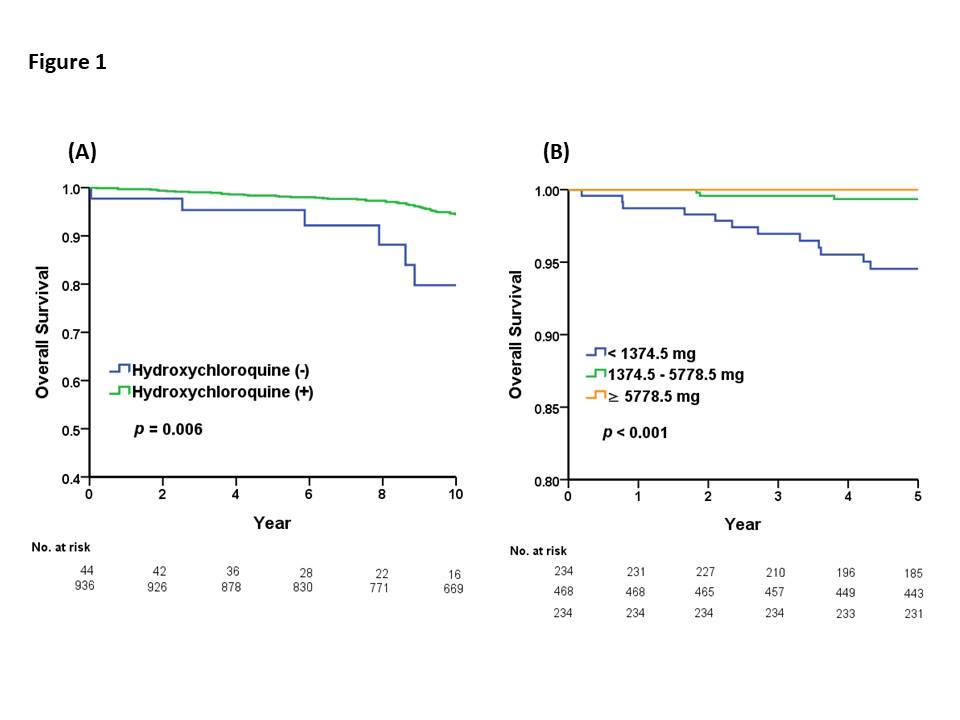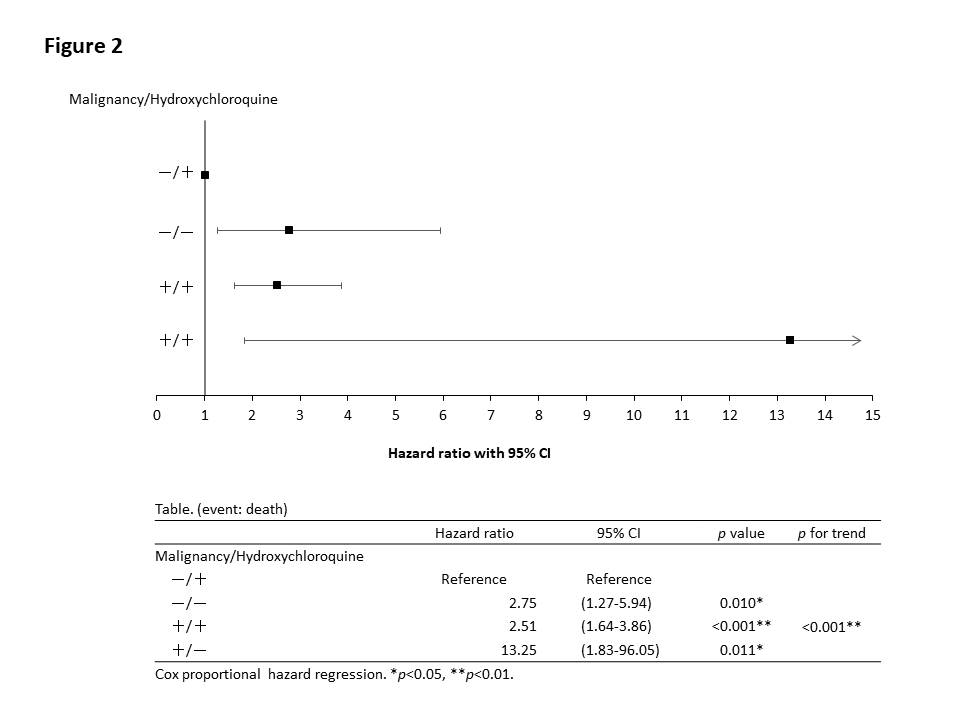Back
Poster Session A
Rheumatoid arthritis (RA)
Session: (0241–0271) RA – Diagnosis, Manifestations, and Outcomes Poster I
0268: Risks of Mortality in Elderly-onset Rheumatoid Arthritis: Analysis from the TRA Clinical Electronic Registry
Saturday, November 12, 2022
1:00 PM – 3:00 PM Eastern Time
Location: Virtual Poster Hall
- CL
Ching-Tsai Lin, MD
Taichung Veterans’ General Hospital
Taichung, Taiwan
Abstract Poster Presenter(s)
Ching-Tsai Lin1, Wen-Nan Huang1, Yi-Hsin Chen2 and Yi-Ming Chen3, 1Division of Allergy, Immunology and Rheumatology, Department of Internal Medicine, Taichung Veterans General Hospital, Taichung, Taiwan, 2Taichung Veterans General Hospital, Taichung, Taiwan, 3Department of Medical Research, Taichung Veterans General Hospital, Taichung, Taiwan
Background/Purpose: Patients with rheumatoid arthritis (RA) were associated with increased mortality rate. Our study aimed to investigate the risk factors associated with all causes of mortality in patients with elderly-onset rheumatoid arthritis (EORA) receiving conventional, biologic or targeted synthetic disease-modifying anti-rheumatic drugs (cDMARDs, bDMARDs or tsDMARDs).
Methods: Data of EORA patients defined as RA diagnosis age >60 years between Jan, 2007 and June, 2021 were extracted from the Taiwan Rheumatology Association Clinical Electronic Registry (TRACER). To evaluate the association of baseline demographic data, pre-existing comorbidities, all causes of death, antibody titers and positivity status for RF, ACPA or both, DMARD-exposure by cDMARD, bDMARD or tsDMARD with mortality risk among EORA patients, we constructed a multivariable cox regression models to calculate the Hazard ratios (HR) and 95% confidence intervals (CI). Five-year patient survival for EORA were analyzed by Kaplan-Meier curves.
Results: A total of 980 EORA patients were recruited ( survival: 852 and death: 128, respectively ). We found that older age (HR: 1.10, 95% CI: 1.07-1.12, p < 0.001), male sex (HR: 1.92, 95% CI: 1.22-3.00, p=0.004), current smoking (HR: 2.31, 95% CI: 1.10-4.87, p=0.027), and underlying malignancy (HR: 1.89, 95% CI: 1.20-2.97, p=0.006) were significant risks of mortality (Table 1). In contrast, hydroxychloroquine (HCQ) treatment was a protective factor against mortality in patients with EORA (HR: 0.30, 95% CI: 0.14-0.64, p=0.002 & Figure 1A). Moreover, patient with malignancy but no HCQ treatment exhibited the highest mortality risk compared with the counterparts (Figure 2). Patients with a monthly cumulative dose of HCQ < 1374.5 mg exhibited the lowest survival rate in comparison to patients with that 1374.5-5778.5mg and ≧5778.5mg (Figure 1B).
Conclusion: Our study identified risks of mortality in patients with EORA. Whether HCQ protects patients with malignancy from deleterious outcome deserves further investigation.
.jpg) Table 1. Cox regression analysis of factors associated with risks of mortality in elderly-onset rheumatoid arthritis
Table 1. Cox regression analysis of factors associated with risks of mortality in elderly-onset rheumatoid arthritis
 Figure 1. (A) The overall 10-year Kaplan-Meier survival probability of hydroxychloroquine and non-hydroxychloroquine group, and (B) the overall 5-year Kaplan-Meier survival probability stratified by monthly cumulative dose of hydroxychloroquine with ≧5778.5mg, 5778.5-1374.5mg and < 1374.5mg in elderly-onset rheumatoid arthritis patients.
Figure 1. (A) The overall 10-year Kaplan-Meier survival probability of hydroxychloroquine and non-hydroxychloroquine group, and (B) the overall 5-year Kaplan-Meier survival probability stratified by monthly cumulative dose of hydroxychloroquine with ≧5778.5mg, 5778.5-1374.5mg and < 1374.5mg in elderly-onset rheumatoid arthritis patients.
Pairwise comparison (A) hydroxychloroquine vs. non-hydroxychloroquine group, p=0.006; (B) monthly cumulative dose of hydroxychloroquine ≧5778.5mg vs. 5778.5-1374.5mg vs. < 1374.5mg, p < 0.001.
 Figure 2: Risk of mortality in elderly-onset rheumatoid arthritis patients stratified by the presence of malignancy and the use of hydroxychloroquine. Error bars represent the 95% confidence intervals (CI) of the Hazard ratios (HR).
Figure 2: Risk of mortality in elderly-onset rheumatoid arthritis patients stratified by the presence of malignancy and the use of hydroxychloroquine. Error bars represent the 95% confidence intervals (CI) of the Hazard ratios (HR).
Disclosures: C. Lin, None; W. Huang, None; Y. Chen, None; Y. Chen, None.
Background/Purpose: Patients with rheumatoid arthritis (RA) were associated with increased mortality rate. Our study aimed to investigate the risk factors associated with all causes of mortality in patients with elderly-onset rheumatoid arthritis (EORA) receiving conventional, biologic or targeted synthetic disease-modifying anti-rheumatic drugs (cDMARDs, bDMARDs or tsDMARDs).
Methods: Data of EORA patients defined as RA diagnosis age >60 years between Jan, 2007 and June, 2021 were extracted from the Taiwan Rheumatology Association Clinical Electronic Registry (TRACER). To evaluate the association of baseline demographic data, pre-existing comorbidities, all causes of death, antibody titers and positivity status for RF, ACPA or both, DMARD-exposure by cDMARD, bDMARD or tsDMARD with mortality risk among EORA patients, we constructed a multivariable cox regression models to calculate the Hazard ratios (HR) and 95% confidence intervals (CI). Five-year patient survival for EORA were analyzed by Kaplan-Meier curves.
Results: A total of 980 EORA patients were recruited ( survival: 852 and death: 128, respectively ). We found that older age (HR: 1.10, 95% CI: 1.07-1.12, p < 0.001), male sex (HR: 1.92, 95% CI: 1.22-3.00, p=0.004), current smoking (HR: 2.31, 95% CI: 1.10-4.87, p=0.027), and underlying malignancy (HR: 1.89, 95% CI: 1.20-2.97, p=0.006) were significant risks of mortality (Table 1). In contrast, hydroxychloroquine (HCQ) treatment was a protective factor against mortality in patients with EORA (HR: 0.30, 95% CI: 0.14-0.64, p=0.002 & Figure 1A). Moreover, patient with malignancy but no HCQ treatment exhibited the highest mortality risk compared with the counterparts (Figure 2). Patients with a monthly cumulative dose of HCQ < 1374.5 mg exhibited the lowest survival rate in comparison to patients with that 1374.5-5778.5mg and ≧5778.5mg (Figure 1B).
Conclusion: Our study identified risks of mortality in patients with EORA. Whether HCQ protects patients with malignancy from deleterious outcome deserves further investigation.
.jpg) Table 1. Cox regression analysis of factors associated with risks of mortality in elderly-onset rheumatoid arthritis
Table 1. Cox regression analysis of factors associated with risks of mortality in elderly-onset rheumatoid arthritis Figure 1. (A) The overall 10-year Kaplan-Meier survival probability of hydroxychloroquine and non-hydroxychloroquine group, and (B) the overall 5-year Kaplan-Meier survival probability stratified by monthly cumulative dose of hydroxychloroquine with ≧5778.5mg, 5778.5-1374.5mg and < 1374.5mg in elderly-onset rheumatoid arthritis patients.
Figure 1. (A) The overall 10-year Kaplan-Meier survival probability of hydroxychloroquine and non-hydroxychloroquine group, and (B) the overall 5-year Kaplan-Meier survival probability stratified by monthly cumulative dose of hydroxychloroquine with ≧5778.5mg, 5778.5-1374.5mg and < 1374.5mg in elderly-onset rheumatoid arthritis patients.Pairwise comparison (A) hydroxychloroquine vs. non-hydroxychloroquine group, p=0.006; (B) monthly cumulative dose of hydroxychloroquine ≧5778.5mg vs. 5778.5-1374.5mg vs. < 1374.5mg, p < 0.001.
 Figure 2: Risk of mortality in elderly-onset rheumatoid arthritis patients stratified by the presence of malignancy and the use of hydroxychloroquine. Error bars represent the 95% confidence intervals (CI) of the Hazard ratios (HR).
Figure 2: Risk of mortality in elderly-onset rheumatoid arthritis patients stratified by the presence of malignancy and the use of hydroxychloroquine. Error bars represent the 95% confidence intervals (CI) of the Hazard ratios (HR). Disclosures: C. Lin, None; W. Huang, None; Y. Chen, None; Y. Chen, None.

